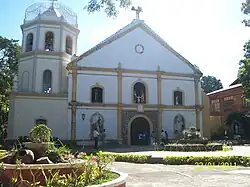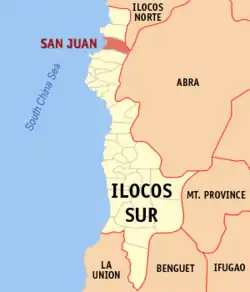San Juan | |
|---|---|
| Municipality of San Juan | |
 St. John the Baptist Catholic Church | |
 Flag  Seal | |
| Nickname: Buri Capital of the Philippines | |
| Motto: Tattan San Juan! (Right Now San Juan) | |
 Map of Ilocos Sur with San Juan highlighted | |
OpenStreetMap | |
.svg.png.webp) San Juan Location within the Philippines | |
| Coordinates: 17°44′35″N 120°27′30″E / 17.7431°N 120.4583°E | |
| Country | Philippines |
| Region | Ilocos Region |
| Province | Ilocos Sur |
| District | 1st district |
| Named for | St. John the Baptist |
| Barangays | 32 (see Barangays) |
| Government | |
| • Type | Sangguniang Bayan |
| • Mayor | Ma. Elaine A. Sarmiento |
| • Vice Mayor | Benjamin V. Sarmiento |
| • Representative | Deogracias Victor B. Savellano |
| • Municipal Council | Members |
| • Electorate | 19,186 voters (2022) |
| Area | |
| • Total | 64.37 km2 (24.85 sq mi) |
| Elevation | 41 m (135 ft) |
| Highest elevation | 307 m (1,007 ft) |
| Lowest elevation | 0 m (0 ft) |
| Population (2020 census)[3] | |
| • Total | 26,674 |
| • Density | 410/km2 (1,100/sq mi) |
| • Households | 6,735 |
| Economy | |
| • Income class | 3rd municipal income class |
| • Poverty incidence | 4.86 |
| • Revenue | ₱ 244.3 million (2020) |
| • Assets | ₱ 1,277 million (2020) |
| • Expenditure | ₱ 243 million (2020) |
| • Liabilities | ₱ 123.4 million (2020) |
| Service provider | |
| • Electricity | Ilocos Sur Electric Cooperative (ISECO) |
| Time zone | UTC+8 (PST) |
| ZIP code | 2731 |
| PSGC | |
| IDD : area code | +63 (0)77 |
| Native languages | Ilocano Tagalog |
San Juan, officially the Municipality of San Juan (Ilocano: Ili ti San Juan; Filipino: Bayan ng San Juan), formerly called as Lapog, is a 3rd class municipality in the province of Ilocos Sur, Philippines. According to the 2020 census, it has a population of 26,674 people.[3]
Because it produces most of the goods made of buri leaf in the province, it is sometimes called the Buri Capital of Ilocos Sur.
Etymology
The town got its name from its patron saint, Saint John the Baptist.
History
The town of Lapog was established in 1772.
The name of the municipality has gone through a series of changes. The early settlers and occupants called it "Lapo", short for "Lapo-Lapo", a tall grass which grew everywhere in the area. In the year 1772, Don Tomas Aquino, the first local leader, initiated the organization of the scattered communities into one, calling the place "Lapog", a derivative of local vernacular "Lap-Lapog" which means unirrigated land. For 189 years, "Lapog" remained in the records as the official name of the town until June 18, 1961, Republic Act No. 3386 was enacted and it was renamed to San Juan. Since most of the inhabitants were of the belief that religious names bring peace, happiness, and prosperity, the town was renamed "San Juan", after the name of its patron saint, Saint John the Baptist.
It was stricken by all sorts of plagues and epidemics (like the smallpox epidemics of 1808 and 1918–19, locust infestation in 1903, and destruction of ricefields by worms called "arabas" in 1905). Bessang Pass, just south of the poblacion, was constructed in 1874. Americans destroyed their town hall in 1903. But despite these misfortunes, San Juan progressed into a prosperous community.
Geography
San Juan is 426 kilometres (265 mi) from Metro Manila and 21 kilometres (13 mi) from Vigan City, the provincial capital. It is bordered to the north by the municipality of Cabugao, to the south by the municipality of Magsingal, to the east by Nueva Era, Ilocos Norte, Bangued, Abra and Langiden, Abra.
Barangays
San Juan is politically subdivided into 32 barangays. [5] Each barangay consists of puroks and some have sitios.
- Asilang
- Bacsil
- Baliw
- Bannuar (Poblacion)
- Barbar
- Cabanglotan
- Cacandongan
- Camanggaan
- Camindoroan
- Caronoan
- Darao
- Dardarat
- Guimod Norte
- Guimod Sur
- Immayos Norte
- Immayos Sur
- Labnig
- Lapting
- Lira (Poblacion)
- Malamin
- Muraya
- Nagsabaran
- Nagsupotan
- Pandayan (Poblacion)
- Refaro
- Resurreccion (Poblacion)
- Sabangan
- San Isidro
- Saoang
- Solotsolot
- Sunggiam
- Surngit
Climate
| Climate data for San Juan, Ilocos Sur | |||||||||||||
|---|---|---|---|---|---|---|---|---|---|---|---|---|---|
| Month | Jan | Feb | Mar | Apr | May | Jun | Jul | Aug | Sep | Oct | Nov | Dec | Year |
| Mean daily maximum °C (°F) | 30 (86) |
31 (88) |
32 (90) |
34 (93) |
33 (91) |
31 (88) |
30 (86) |
30 (86) |
30 (86) |
31 (88) |
30 (86) |
29 (84) |
31 (88) |
| Mean daily minimum °C (°F) | 18 (64) |
19 (66) |
21 (70) |
23 (73) |
24 (75) |
25 (77) |
24 (75) |
24 (75) |
24 (75) |
22 (72) |
21 (70) |
19 (66) |
22 (72) |
| Average precipitation mm (inches) | 9 (0.4) |
11 (0.4) |
13 (0.5) |
23 (0.9) |
92 (3.6) |
122 (4.8) |
153 (6.0) |
137 (5.4) |
139 (5.5) |
141 (5.6) |
42 (1.7) |
14 (0.6) |
896 (35.4) |
| Average rainy days | 4.6 | 4.0 | 6.2 | 9.1 | 19.5 | 23.2 | 24.0 | 22.5 | 21.5 | 15.2 | 10.5 | 6.0 | 166.3 |
| Source: Meteoblue (modeled/calculated data, not measured locally)[6] | |||||||||||||
Demographics
|
|
| ||||||||||||||||||||||||||||||||||||||||||||||||||||||
| Source: Philippine Statistics Authority[7][8][9][10] | ||||||||||||||||||||||||||||||||||||||||||||||||||||||||
In the 2020 census, San Juan had a population of 26,674.[3] The population density was 410 inhabitants per square kilometre (1,100/sq mi).
Economy
Government
Local government
San Juan, belonging to the first congressional district of the province of Ilocos Sur, is governed by a mayor designated as its local chief executive and by a municipal council as its legislative body in accordance with the Local Government Code. The mayor, vice mayor, and the councilors are elected directly by the people through an election which is being held every three years.
Elected officials
| Position | Name |
|---|---|
| Congressman | Deogracias Victor B. Savellano |
| Mayor | Ma. Elaine A. Sarmiento |
| Vice-Mayor | Benjamin V. Sarmiento |
| Councilors | Rizalina A. Valle |
| Cresencio G. Valle | |
| Gem Paula V. Lucero | |
| Michael B. Sumagit | |
| Edwin B. Singzon | |
| Rafael Vincent P. Ochosa | |
| Florante A. Ramos | |
|
Domingo M. Oli | |
See also
References
- ↑ Municipality of San Juan | (DILG)
- ↑ "2015 Census of Population, Report No. 3 – Population, Land Area, and Population Density" (PDF). Philippine Statistics Authority. Quezon City, Philippines. August 2016. ISSN 0117-1453. Archived (PDF) from the original on May 25, 2021. Retrieved July 16, 2021.
- 1 2 3 Census of Population (2020). "Region I (Ilocos Region)". Total Population by Province, City, Municipality and Barangay. Philippine Statistics Authority. Retrieved 8 July 2021.
- ↑ "PSA Releases the 2018 Municipal and City Level Poverty Estimates". Philippine Statistics Authority. 15 December 2021. Retrieved 22 January 2022.
- ↑ "Province: Ilocos Sur". PSGC Interactive. Quezon City, Philippines: Philippine Statistics Authority. Retrieved 12 November 2016.
- ↑ "San Juan: Average Temperatures and Rainfall". Meteoblue. Retrieved 14 May 2020.
- ↑ Census of Population (2015). "Region I (Ilocos Region)". Total Population by Province, City, Municipality and Barangay. Philippine Statistics Authority. Retrieved 20 June 2016.
- ↑ Census of Population and Housing (2010). "Region I (Ilocos Region)" (PDF). Total Population by Province, City, Municipality and Barangay. National Statistics Office. Retrieved 29 June 2016.
- ↑ Censuses of Population (1903–2007). "Region I (Ilocos Region)". Table 1. Population Enumerated in Various Censuses by Province/Highly Urbanized City: 1903 to 2007. National Statistics Office.
{{cite encyclopedia}}: CS1 maint: numeric names: authors list (link) - ↑ "Province of Ilocos Sur". Municipality Population Data. Local Water Utilities Administration Research Division. Retrieved 17 December 2016.
- ↑ "Poverty incidence (PI):". Philippine Statistics Authority. Retrieved December 28, 2020.
- ↑ "Estimation of Local Poverty in the Philippines" (PDF). Philippine Statistics Authority. 29 November 2005.
- ↑ "2003 City and Municipal Level Poverty Estimates" (PDF). Philippine Statistics Authority. 23 March 2009.
- ↑ "City and Municipal Level Poverty Estimates; 2006 and 2009" (PDF). Philippine Statistics Authority. 3 August 2012.
- ↑ "2012 Municipal and City Level Poverty Estimates" (PDF). Philippine Statistics Authority. 31 May 2016.
- ↑ "Municipal and City Level Small Area Poverty Estimates; 2009, 2012 and 2015". Philippine Statistics Authority. 10 July 2019.
- ↑ "PSA Releases the 2018 Municipal and City Level Poverty Estimates". Philippine Statistics Authority. 15 December 2021. Retrieved 22 January 2022.
- ↑ "2019 National and Local Elections" (PDF). Commission on Elections. Retrieved March 11, 2022.